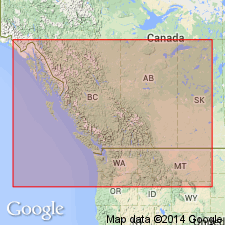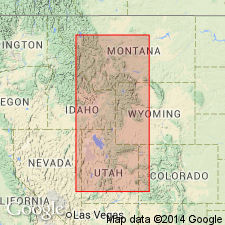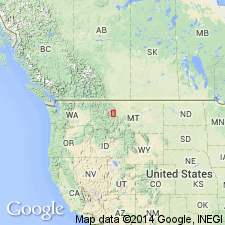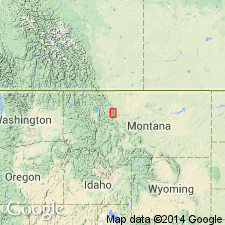
- Usage in publication:
-
- Gordon shale
- Modifications:
-
- Original reference
- Dominant lithology:
-
- Shale
- AAPG geologic province:
-
- Montana folded belt
Summary:
No. 1, Pub. 2444, p. 7-8, and No. 2, Pub. 2445, p. 16-19. Gordon shale. A name proposed for the fine argillaceous shales carrying ALBERTELLA fauna in Montana. Of greensih and purplish color. Thickness 284 feet on ridge between Gordon and Youngs Creeks, Powell County, central western Montana. [Detailed section given.] Underlies Meagher limestone and overlies Flathead(?) sandstone. Age is Middle Cambrian.
Type locality: on Gordon Creek, 6 mi from South Fork of Flathead River, Ovando quadrangle, Powell Co., central western MT. The shale extends across the ridge btw. Gordon and Youngs Creek, about halfway btw. Gordon Mtn. and Cardinal Peak.
Source: US geologic names lexicon (USGS Bull. 896, p. 841).

- Usage in publication:
-
- Gordon shale
- Modifications:
-
- Revised
- AAPG geologic province:
-
- Montana folded belt
Summary:
Pg. 1076, 1082, 1087-1088, 1089-1090. Deiss, 1933 (Montana Bur. Mines and Geol. Mem., no. 6) divided Cambrian of northwestern Montana into 11 formations (ascending): Flathead quartzite, Wolsey shale, Damnation limestone, Nannie Basin limestone, Dearborn limestone, Steamboat limestone, Pagoda oolite, Pentagon shale, Gordon Mountain limestone, Switchback limestone and Devils Glen dolomite. This sequence is revised as follows: Flathead sandstone, Gordon shale (instead of Wolsey), Damnation limestone (redefined to include Nannie Basin), Dearborn limestone, Pagoda limestone, Pentagon shale, Steamboat limestone (replaces Gordon Mountain limestone), Switchback shale, and Devils Glen dolomite. All appear to be Middle Cambrian. Thickness Gordon shale 140 to 274 feet.
Source: US geologic names lexicon (USGS Bull. 1200, p. 1547).

- Usage in publication:
-
- Gordon shale
- Modifications:
-
- Biostratigraphic dating
- AAPG geologic province:
-
- Montana folded belt
Summary:
Description of ALBERTELLA trilobite fauna in lower part(?) of unit and ANORIA-CLAVASPIDELLA-ZACANTHOIDES trilobite fauna in upper part, Lewis and Clark Range area, northwestern Montana. Age is Middle Cambrian.
Source: Modified from GNU records (USGS DDS-6; Denver GNULEX).

- Usage in publication:
-
- Gordon shale*
- Modifications:
-
- Areal extent
- AAPG geologic province:
-
- Montana folded belt
- Sweetgrass arch
Summary:
Pg. 219-220. Gordon shale. Described in Saypo quadrangle where it is approximately 220 feet thick; overlies Flathead sandstone and underlies Damnation limestone. [Age is Middle Cambrian.]
Source: US geologic names lexicon (USGS Bull. 1200, p. 1547).
For more information, please contact Nancy Stamm, Geologic Names Committee Secretary.
Asterisk (*) indicates published by U.S. Geological Survey authors.
"No current usage" (†) implies that a name has been abandoned or has fallen into disuse. Former usage and, if known, replacement name given in parentheses ( ).
Slash (/) indicates name conflicts with nomenclatural guidelines (CSN, 1933; ACSN, 1961, 1970; NACSN, 1983, 2005, 2021). May be explained within brackets ([ ]).

